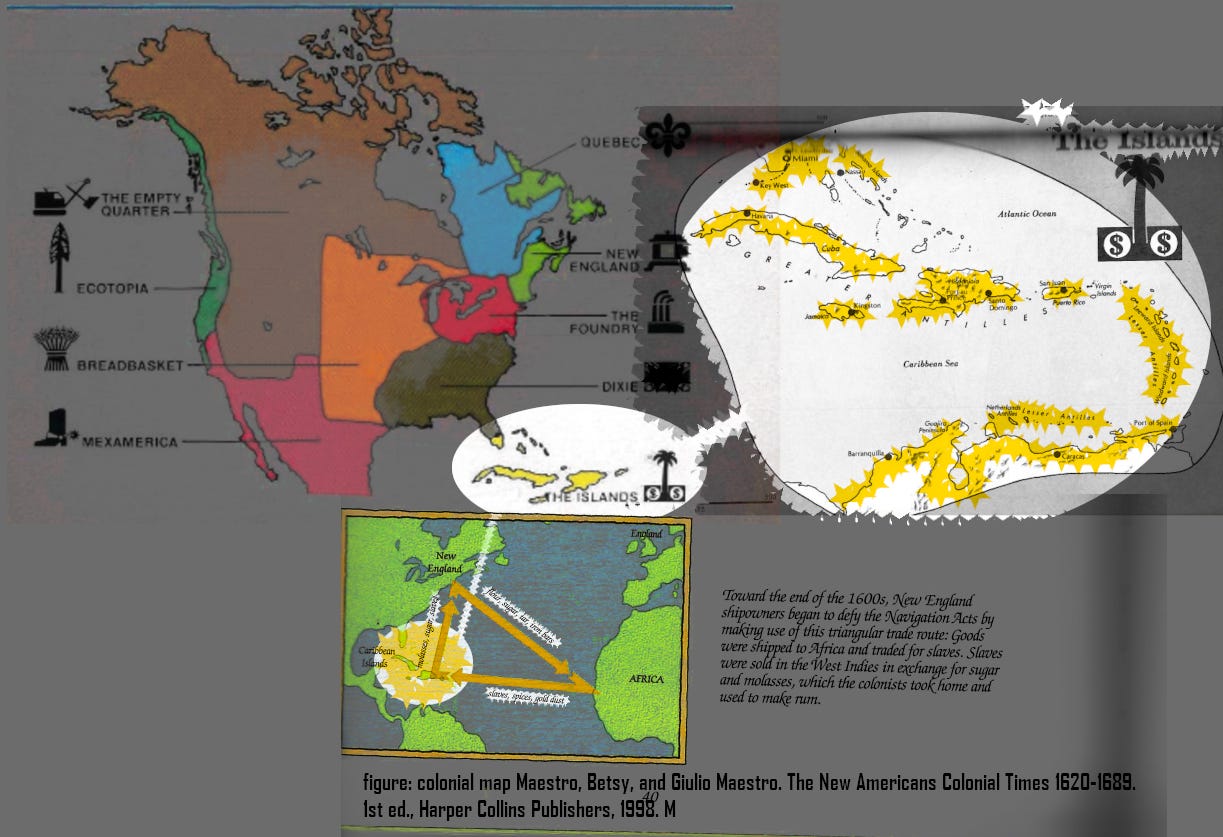Nine Nations - The Islands
Spanish ingress from Arawak to Aztec to Arapahoe w/ Potosi down below
“The DEA says cocaine goes through six transactions between the grower and the user. In four of them, its value doubles. In the first and last, it increases by a factor of 10-20. The South American peasant sells 500 kilos of cocoa leaves for $250. Step two: leaves are reduced to 2.5 kilos of paste, which sells for $5K. Step three, that paste is processed into one kilo of cocaine base that sells for $10K. Step four the base is crystallized by a Colombian lab and sells for $20K. Step five smuggled to Florida, where it sells for $40K. Step six its cut and sold by distributors for $80K. Step seven the retailers cut and sell for $800K.
…
There are a very few legitimate reasons for using Netherlands Antilles’ anonymous corporations. The most commonly cited is the case of an industrialist who wants to hide his true worth lest his family attract the attentions of terrorists seeking ransom money. But there isn’t a law enforcement agent alive who thinks there are enough terrorists in the whole world to make such considerations alone the reason remote islands have become major world finance centers.”
The Islands. Nine Nations
“Las Casas tells how the Spaniards “grew more conceited every day” and after a while refused to walk any distance. They “rode the backs of Indians if they were in a hurry” or were carried on hammocks by Indians running in relays. “In this case they also had Indians carry large leaves to shade them from the sun and others to fan them with goose wings.” Total control led to total cruelty. The Spaniards “thought nothing of knifing Indians by tens and twenties and of cutting slices off them to test the sharpness of their blades.” Las Casas tells how “two of these so-called Christians met two Indian boys one day, each carrying a parrot; they took the parrots and for fun beheaded the boys.”
Howard Zinna A People’s History of the United States
Consider a hypothetical - imagine a tribe of hominids were discovered. Imagine the taxonomists say that after analyzing their genetics and physical characteristics it is determined that these creatures are not homo sapiens, but they are pigmy neanderthal. In some ways they are eerily human. For example, they make and use tools. They have language. They have fewer vocal chords. Their language sounds like the birds calls. It is similar to Chinese, int that it is tonal, and German, in that vocabulary builds and builds. In other ways it is understood they are very different - they have no concept of time - everything that happens win their life time from birth to death is immediate. The point is to ask, would you see them as human? If someone shot and killed a pygmy neanderthal, would you call it murder? Would the law call it murder? Would they have human rights? It is not clear that the Spanish ever saw native peoples they encountered as any more than an interesting animal. They were anything but hombres in the eyes of Spanish steel wielding gold ravenous God-fearing Spaniard. A second point to make with respect to the differences under Spanish, French and English colonization - The Spaniards came to loot, pillage and go home. The French came to make money and go home. The English came to live and leave England behind.
The colonials paved over the Taino peoples with a watery highway of dark trade. The colonial legacy turned the Islands into a highway for illicit flows - from the triangle of ships running slaves from Africa and spices from The Islands to the colonies. Today, in addition to being a playground for drug money - the Islands are awash in misery with Haiti being foremost basket-case.[1]
Mr. Garreau calls Miami the capital of the Islands nation. That seems fair. The native Creek people in South Florida suffered as all tribes did in the aftermath of the American independence from the British - and the aftermath of nation building American marginalization of the British’s former allies and trade partners. The post on Dixie will dig into this a bit more. From the perspective of The Islands nation and its historical roots in native peoples - hopefully it is fair to say that this region was a portal through which some of America’s greatest evils, the slave trade, flowed - as well the first points of contact for the bloody Spanish savages.
The gunkhole is … halfway between downtown and the airport, its a somewhat trashed oasis. Its lined with docked craft ranging from cabin cruisers to rust buckets over a hundred feet long that haul, between islands, TV dinners or whatever.
…
Its obviously possible to overestimate the importance of the drug and intrigue industries of the Islands. Millions of its citizens, after all, go about their business every day without knowing a joint from a shuffleboard cue. But ignoring the dope presence in the Islands is like trying to ignore oil in Texas. - Nine Nations of North America
Should Puerto Rico be admitted immediately into the Union as a federated State? Yes. oc fourse.
Notes
[1] For more information on the colonial history of the Caribbean and South America -
References
Garreau, Joel. The Nine Nations of North America. 1st ed., Avon Books, 1981.
Zinn, Howard. A People's History of the United States: 1492 to Present. Rev. and updated ed. New York, HarperPerennial, 1995.
Bringing Taíno Peoples Back Into History | At the Smithsonian| Smithsonian Magazine
Mann, Charles C. 1491 : New Revelations of the Americas before Columbus. New York :Knopf, 2005.
https://indigenouspeoplesresources.com/
Maestro, Betsy, and Giulio Maestro. The New Americans Colonial Times 1620-1689. 1st ed., Harper Collins Publishers, 1998.




